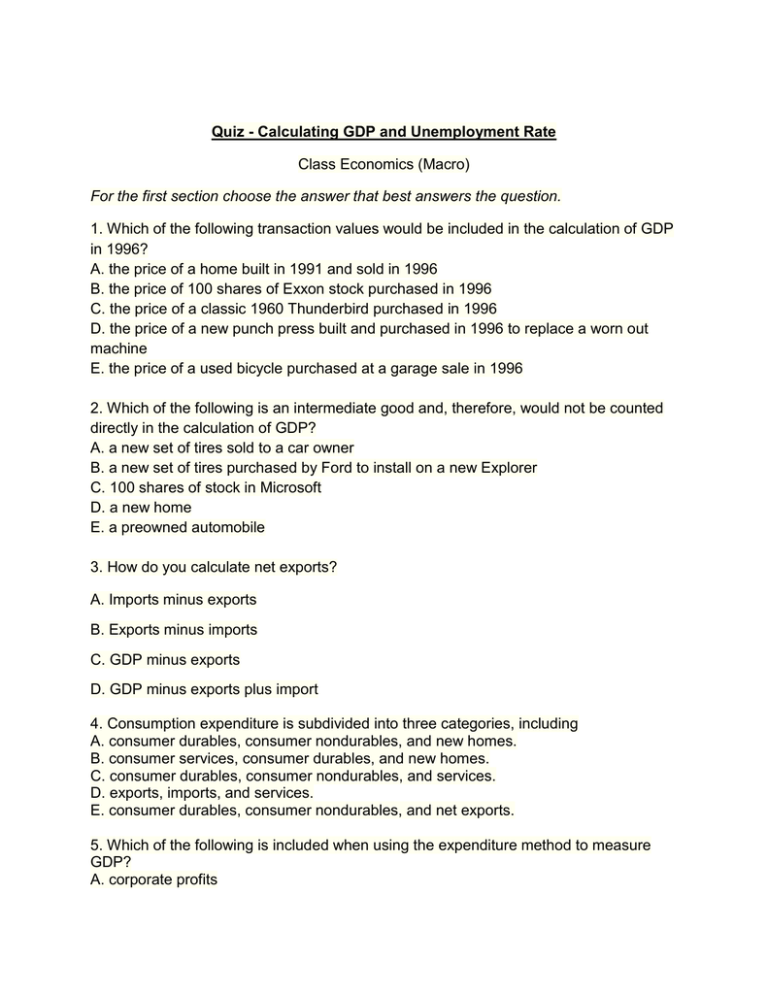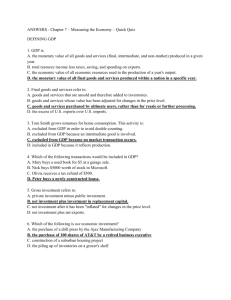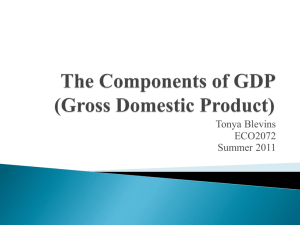Quiz - Calculating GDP and Unemployment Rate Class Economics
advertisement

Quiz - Calculating GDP and Unemployment Rate Class Economics (Macro) For the first section choose the answer that best answers the question. 1. Which of the following transaction values would be included in the calculation of GDP in 1996? A. the price of a home built in 1991 and sold in 1996 B. the price of 100 shares of Exxon stock purchased in 1996 C. the price of a classic 1960 Thunderbird purchased in 1996 D. the price of a new punch press built and purchased in 1996 to replace a worn out machine E. the price of a used bicycle purchased at a garage sale in 1996 2. Which of the following is an intermediate good and, therefore, would not be counted directly in the calculation of GDP? A. a new set of tires sold to a car owner B. a new set of tires purchased by Ford to install on a new Explorer C. 100 shares of stock in Microsoft D. a new home E. a preowned automobile 3. How do you calculate net exports? A. Imports minus exports B. Exports minus imports C. GDP minus exports D. GDP minus exports plus import 4. Consumption expenditure is subdivided into three categories, including A. consumer durables, consumer nondurables, and new homes. B. consumer services, consumer durables, and new homes. C. consumer durables, consumer nondurables, and services. D. exports, imports, and services. E. consumer durables, consumer nondurables, and net exports. 5. Which of the following is included when using the expenditure method to measure GDP? A. corporate profits B. gross private domestic investment C. capital income D. net interest on the government debt E. labor income 6. Which of the following is included when using the labor and capital income method to measure GDP? A. government purchases of goods and services B. net exports of goods and services C. household consumption expenditures D. gross private domestic investment E. business profits 7. If the value of imports is greater than the value of exports, then A. net exports are negative. B. net exports are positive. C. the budget deficit is negative. D. net exports are not, under such circumstances, included in the calculation of GDP. E. the budget deficit is positive. 8. To calculate nominal GDP, the quantities of goods and services are valued at prices in the _____ year, but to calculate real GDP they are valued at _____-year prices. A. current; base B. base; current C. current; current D. base; base E. current; initial 9. Real GDP is GDP adjusted for _____. A. changes in the quality of goods and services B. value added during a previous year C. inflation D. imports E. changes in the cost of intermediate goods and services 10.The duration of unemployment _____. A. rises during recessions B. falls during recessions C. is a period during which an individual is continuously unemployed D. is shorter for the chronically unemployed than it is for the long-term unemployed E. is of less importance to macroeconomics than the costs of unemployment 11. GDP would be a better measure of economic well-being if it included _____. A. the costs of education B. the total value of intermediate goods C. the market value of final goods D. the sales of corporate stock E. leisure 12. Despite some problems with equating GDP with economic well-being, real GDP per person does imply greater economic well-being because it tends to be positively associated with _____. A. crime, pollution, and economic inequality B. better education, health, and life expectancy C. poverty, depletion of nonrenewable resources, and congestion D. unemployment, availability of goods and services, and better education E. the total quantity of goods and services available 13. The official unemployment rate is calculated as _____. A. the number of working-age people 16 years of age or older who are employed divided by the number of people in the labor force B. all people 18 years of age or older who are employed, plus all those unemployed who are actively seeking work C. the percentage of the working-age population 16 years of age or older who are not working but are actively seeking work D. the number of people 16 years of age or older who are not employed and are actively seeking work divided by the number of people in the labor force E. all people 16 years of age or older who are employed, plus all those unemployed who are actively seeking work, divided by the number of people in the labor force 14. In the monthly survey conducted by the Bureau of Labor Statistics, a person who was not working during the previous week and was not actively seeking work during the previous four weeks is classified as _____. A. employed B. unemployed C. underemployed D. part-time employed E. not a member of the labor force 15. Goods and services that are used up in the production of other goods and services are called _____ goods and services. A. intermediate B. final C. value added D. nominal E. real 16. An unemployment spell begins when a worker _____. A. losses his/her job and ends when he/she finds a new job B. losses his/her job and ends when he/she finds a new job or leaves the labor force C. starts to actively look for employment and ends when he/she finds a new job D. is not working and starts to actively look for employment and ends when he/she finds a new job or leaves the labor force E. becomes discouraged and stops seeking employment and ends when he/she begins to actively look for employment For the following problems make sure to show your work for you calculations so that you can receive partial credit even if you’re wrong. 17. If a pizza maker pays $3 for pepperoni produced in 2004, $4 for tomatoes produced in 2005, $5 for cheese produced in 2005, and sells the pizza made with all of these ingredients in 2005 for $16, then these activities contribute _____ to 2005 GDP? 18. 15. Data for an economy shows that the working age population consists of 1,000,000 people, 400,000 people are employed, and the (labor force) participation rate is 50 percent. The unemployment rate for this economy is _____. 19. Suppose the market value of output in a country increased from $500 billion in 2000 to $750 billion in 2005. If prices, as measured by a price index, increased from 200 in 2000 to 250 in 2005, then real GDP for the country in 2005 was _____. 20. Use the information below to calculate the value added by the firm. Rent paid for office space: $40,000 Wages paid to workers: $260,000 Value of produced inputs used up to produce the firm's output that were purchased from other firms: $400,000 Value of firm's output: $900,000







